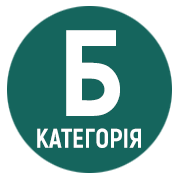A “LITTLE” TRAGEDY ON THE MARGINS OF “BIG HISTORIES”: THE ROMANI GENOCIDE IN VOLHYNIA, 1941–1944
Abstract
During the Second World War, Volyn was the scene of brutal violence and fierce confrontation between different groups. The victims in many cases were civilians. While the fate of many groups attracts the attention of historians and is the subject of heated public debate, the fate of Roma, a small minority, remains in the shadows. Meanwhile, this group suffered almost total extermination during the war, and the persecution of this minority bore the hallmarks of genocide. In order to cover the formation of the anti-Roma policy and the fate of those declared an “undesirable elements,” the author explores a combination of factors that played a role: (1) the heterogeneity of Roma as a group led to sometimes unequal treatment during the war, because the factor of “nomadic” or “sedentary” way of life of Roma was important at least for a part of the occupation administration; (2) the duties of the various branches of the occupation authorities, such as the German civil administration and the SS police, who initially involved different approaches to the “Gypsy question,” but soon were agreed upon and unified due to the primacy of the SS-police in solving “security issues”; (3) the lack of clarity and completeness of the instructions on the “Gypsy question” from Berlin was compensated by the initiatives of local authorities, which handled this issue according to their own needs and local conditions; (4) the attitudes of the local population, both its civilian part and that one which participated in the occupation administrative and police apparatus, greatly improved the mechanism of persecution, helping the occupiers to “solve” effectively the “Gypsy question”; however, the significant closeness of at least part of the Roma community to the local population determined the extensive help to Roma in some places; (5) the position of independent collective military and political actors (Ukrainian and Soviet partisan movements), which enabled the rescue of a certain parts of the Roma community. The issue is explored in the context of the developments in Volyn during the war and the escalation of violence in the region, including most tragic episodes, such as the “final solution of the Jewish question” and the Volhynian massacre.
References
2. Gontarek A. Political Activity of Kwiek ‘Dynasty’ in the Second Polish Republic in the Years 1935–1939. Social Inclusion. 2020, Vol 8, No 2, P. 336–345.
3. Klímová-Alexander I. The development and institutionalization of Romani representation and administration. Part 2: Beginnings of modern institutionalization (nineteenth century—World War II). Nationalities Papers. 2005. Vol 33, No 2. P. 177–185.
4. Kapralski S. Collaboration and the Genocide of Roma in Poland / eds. G. Grinchenko, E. Narvselius. Traitors, Collaborators and Deserters in Contemporary Eurопean Politics of Memory. London: Palgrave Macmillan Cham. 2018. P. 215–240.
5. Hryciuk G. Victims 1939–1941: The Soviet Repressions in Eastern Poland. In: Shared History-Divided Memory: Jews and Others in Soviet-Occupied Poland / eds. E. Bаркan, E. А. Соlе, К. Struve. Leipzig: Leipzig University-Verlag, 2007. Р. 178–184.
6. Галузевий архів СБУ, ф. 16, спр. 515, арк. 118–121.
7. Олійник Ю.В., Завальнюк О.М. Нацистський окупаційний режим в генеральній окрузі «Волинь-Поділля» (1941–1944 рр.). Хмельницький : Поліграфіст-2, 2012. 320 с.
8. Pohl D. The Murder of Ukraine’s Jews under German Military Administration and in the Reich Commissariat Ukraine. In: Shoah in Ukraine: history, testimony, memorialization / eds. R. Brandon, W. Lower. Bloomington: Indiana University Press, in association with the United States Holocaust Memorial Museum, 2008. P. 23–76.
9. Lewy G. The Nazi Persecution of the Gypsies. Oxford: Oxford University Press, 2000. 306 p.
10. Державний архів Волинської області, ф. Р-2, оп. 1, спр. 8-б.
11. Державний архів Рівненської області, ф. Р-23, оп. 1, спр. 1.
12. Державний архів Рівненської області, ф. Р-23, оп. 1, спр. 3.
13. Державний архів Рівненської області, ф. Р-57, оп. 1, спр. 1.
14. Дімент М. Самотній вигнанець. Щоденник про Свинюхи та гетто в Локачах. Київ : Укр. центр вивч. історії Голокосту, 2016. 200 с.
15. Yahad – In Unum Archives, testimony № 1480.
16. Центральний державний архів вищих органів влади та управління України, ф. 3676, оп. 4, спр. 317.
17. Круглов А. Геноцид циган в Украине в 1941–1944 гг.: статистико-региональный аспект. Голокост і сучасність. Студії в Україні і світі. 2009. № 2(6). С. 83–113.
18. Yahad – In Unum Archives, testimony № 525.
19. Yahad – In Unum Archives, testimony № 532.
20. Государственный архив Российской Федерации, ф. 7021, оп. 71, д. 70.
21. Государственный архив Российской Федерации, ф. 7021, оп. 71, д. 44.
22. Державний архів Волинської області, ф. Р-164, оп. 3, спр. 38.
23. Государственный архив Российской Федерации, ф. 7021, оп. 55, д. 11.
24. Государственный архив Российской Федерации, ф. 7021, оп. 71, д. 44.
25. Державний архів Волинської області, ф. Р-66, оп. 1, спр. 15.
26. Dębicki E. Ptak umarłych. Warsaw: Bellona, 2004. 223 s.
27. Dębski W. S. Bylo sobie miasteczko: Оpowiesc wolynska. Lublin: Polihymnia, 2006. 556 s.
28. Yahad – In Unum Archives, testimony № 448.
29. Yahad – In Unum Archives, testimony № 450.
30. Архів Українського центру вивчення історії Голокосту, інтерв’ю з Лідією Литвинчук, 2011 р.
31. Архів управління Служби безпеки України у Волинській області, ф. 5, спр. 21282.
32. Бессонов Н. Геноцид цыган Украины в годы Великой Oтечественной войны. Рома в Украïнi. Iсторичний та етнокультурний розвиток циган (рома) Украiни (XVI–XX ст.) Матер. мiжнарод. кругл. столу 3 листоп. 2006 р. Севастополь : Вебер, 2006. С. 4–28.
33. Goldhagen D. J. The “humanist” as a mass murderer: The Mind and Deeds of SS General Otto Ohlendorf. An Essay Presented to The Committee on Degrees in Social Studies in partial fulfillment of the requirements for the degree with honors of Bachelor of Arts. Harvard, 1982.
34. Tyaglyy M. Were the “Chingene” Victims of the Holocaust? The Nazi policy toward the Crimean Roma. Holocaust and Genocide Studies. 2009, Vol. 23, No. 1. P. 26–53.
35. Holler M. Extending the Genocidal Program. Did Otto Ohlendorf Initiate the Systematic Extermination of Soviet “Gypsies”? In: Nazi Policy on the Eastern Front, 1941: Total War, Genocide, and Radicalization / eds. A. J. Kay, J. Rutherford, D. Stahel. Rochester, NY: University of Rochester Press, 2012. P. 267–288.
36. Центральний державний архів вищих органів влади та управління України, ф. 3206, оп. 1, спр. 105.
37. Центральний державний архів громадських об’єднань України, ф. 57, оп. 4. спр. 370.
38. Сергійчук В. ОУН-УПА в роки війни. Нові документи і матеріали. Київ : Дніпро, 1996.
39. Літопис УПА. Нова серія. Т. 17. Київ; Торонто, 2011.
40. Ficowski J. Cyganie na polskich drogach. Kraków: Wydawnictwo Literackie, 1965. 389 s.
41. Jastrzębska M. (...) co za Niemców przeszliśmy na Wołyniu w 1943 i 44 roku. Tekstualia: palimpsesty literackie, artystyczne, naukowe. 2013. Vol 33, No 2. P. 149–159.
42. Kledzik E. „Panowie! Za co nas będziecie wybijać?” Wołyńskie wspomnienia rodziny Krzyżanowskich w relacji Jerzego Ficowskiego. Narracje o Zagładzie, 2020, № 6. P. 165–202.
43. Волинь і Полісся: німецька окупація = [Volyn and Polyssya: German occupation]. Ред. Є. Штендера. Торонто : Літопис УПА, 1984.
44. Бессонов Н. Цыганская трагедия 1941–1945: Факты, документы, воспоминания. Т. 2: Вооруженный отпор. Санкт-Петербург : Издательский дом «Шатра», 2010. 376 с.
45. Стародубець Г.М. Міжнаціональні відносини в рамках повстанського запілля в 1943 році. Історичні уроки Голокосту та міжнаціональні відносини: Матеріали міжнародної науково-практичної конференції для викладачів та студентів: Збірник наукових праць. Дніпропетровськ, 2010.
46. Архів Українського центру вивчення історії Голокосту, інтерв’ю з Ганною Стоянович, 2017.
47. Рачковський Г. Цигани в українській паремії. Народознавчі зошити. 2005. № 3/4. С. 397–401.
48. Шума Л. Етнічний стереотип рома (цигана) в народних легендах. Studia methodologica. 2016. № 43. С. 128–135.
49. Мільчарчик Е. Люди – не-люди, тобто про циган в народних переказах та прислів'ях. Народознавчі зошити. 2005, № 3/4. С. 383–396.
50. Патриляк І. «Еведенційні картки» УПА як статистичне джерело. Український визвольний рух. 2006. № 6. С. 110–146.
51. Літопис УПА. Т. 37. Іван Лико. На грані мрії і дійсності (спогади підпільника). Торонто : Вид-во Літопис УПА, 2002. C. 9–486.
52. Літопис УПА. Т. 37. Микола Терефенко. На грані двох світів (спогади). Торонто : Вид-во Літопис УПА, 2002. C. 487–626.
53. Архів управління СБУ у Рівненській області, ф. 4, спр. № 897.
54. Snyder T. The Reconstruction of Nations: Poland, Ukraine, Lithuania, Belarus, 1569–1999. Yale : Yale University Press, 2003. 384 p.
55. McBride J. Peasants into Perpetrators: The OUN-UPA and the Ethnic Cleansing of Volhynia, 1943–1944. Slavic Review. 2016, Vol 75, No. 3. P. 630–654.
56. Motyka G. Ukrainska partyzantka 1942−1960. Działalnosc Organizacji Ukrainskich Nacjonalistów i Ukrainskiej Powstanczej Armii. Warszawa : Instytut Studiów Politycznych PAN, 2006. 728 s.
57. Шеремет М. В тилу ворога (6 марта – 1 апреля 1943 г.). Партизанські колекції Національного музею історії України у Другій світовій війні. Щоденники / редкол.: Л.В. Легасова (кер. проекту) та ін. Київ : Ін-т історії України НАН України, Національний музей історії України у Другій світовій війні. Меморіальний комплекс; Аеростат, 2015. С. 147–190.
58. Шкрябач Я. П. Дорога в Молдавию: воспоминания командира. Кишинев : Картя Молдовеняскэ, 1966.
59. Державний архів Рівненської області, ф. Р-48, оп. 1, спр. 11.
60. Государственный архив Российской Федерации, ф. 7021, оп. 71, д. 54.
61. Державний архів Волинської області, ф. Р-75, оп. 3, спр. 1.
62. Архів Українського центру вивчення історії Голокосту, інтерв’ю з Любов’ю Козелець, 2017.
63. Архів Українського центру вивчення історії Голокосту, інтерв’ю з Парасковією Стоянович, 2017.
64. Yad Vashem Archives, collection O.33, file 8531.
65. Гогун А., Церович М. Воспоминания ветерана Лельчицкой партизанской бригады ГРУ Т. Марковской. Голокост і сучасність. Студії в Україні і світі. 2009. № 1(5). С. 71–103.
66. Архів управління СБУ у Волинській області, ф. 5, спр. 23017, т. 33.
67. Архів управління СБУ у Волинській області, ф. 5, спр. 17853.
68. Архів управління СБУ у Волинській області, ф. 5, спр. 21695, т. 7.
69. Прусин А. Украинская полиция и Холокост в генеральном округе Киев, 1941–1943: действия и мотивации. Голокост і сучасність. Студії в Україні і світі. 2007. № 1(2). С. 31–59.
70. Wajs-Papusza B. Lesie, ojcze mój. Z języka cygańskiego przetłumaczył, wstępem i przypisami оpatrzył J. Ficowski. Warszawa: Czytelnik, 1990. 92 p.
71. Semczyszyn M. Zagłada Cyganów na Wołyniu i w Galicji Wschodniej podczas okupacji niemieckiej (1941–1944). In: Kustosz cygańskiej pamięci. Księga dedykowana Edwardowi Dębickiemu / eds. P. J. Krzyżanowski, B. A. Orłowska and K. Wasilewski. Gorzów Wielkоpolski: Wojewódzka i Miejska Biblioteka Publiczna im. Zbigniewa Herberta; Akademia im. Jakuba z Paradyża. 2020. S. 303–322.
72. Ленчовська А. Відеосвідчення Інституту Фонду Шоа як джерело до вивчення та викладання історії ромів України у період 1941–1944 рр. Голокост і сучасність. Студії в Україні і світі. 2009. № 2(6). С. 114–123.
73. Тяглий М.І. Картографування геноциду ромів України (1941–1944 рр.) та пам’яті про це. City History, Culture, Society, 2021, № 1(12). С. 118–169.
74. Михман Д. Историография Катастрофы. Еврейский взгляд. Концептуализация, терминология, подходы и фундаментальные вопросы. Днепропетровск : НПЦ «Ткума», 2005 (Розділ «Еврейское сопротивление во время Катастрофы и его значение: теоретические наблюдения». С. 241–273).
75. Abakunova A. Roma and Sinti Self-Rescue in Occupied Soviet Ukraine During the Second World War: Escape, Hiding, and Identity Concealment. In: Stradanje Roma u Europi za vrijeme Drugog svjetskog rata s posebnim osvrtom na stradanje u Nezavisnoj Državi Hrvatskoj. Zbornik radova s međunarodnog znanstvenog skupa. Urednici: dr. sc. Danijel Vojak; Ivo Pejaković, prof. Savez Roma u Republici Hrvatskoj. Jasenovac, 2018. P. 15–28.
76. Geller Yi. The Destruction of the City of Sarny. URL: https://www.jewishgen.org/yizkor/sarny/sar271.html.
77. Spector Sh. The Holocaust of the Volhynian Jews. Jerusalem : Yad Vashem; The Federation of the Volhynian Jews, 1990. 383 p.



